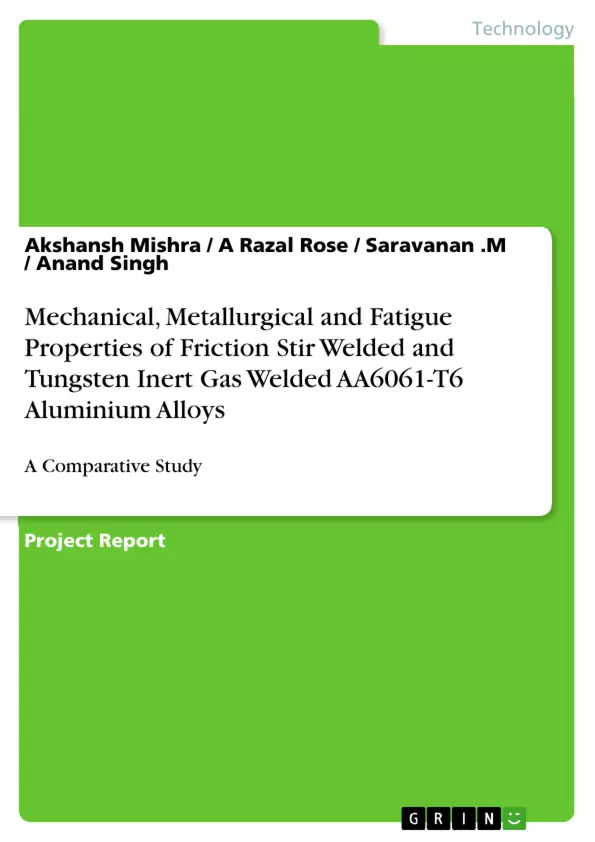This paper deals with the mechanical, microstructural and fatigue analysis of welded joints.
In the study, 6061-T6 aluminium alloy plates in 4mm thickness, that are particularly used for aerospace and in automotive industries, were welded using Tungsten Inert Gas (TIG) welding and Friction Stir Welding (FSW) methods as similar joints with one side pass and parameters of varying tool rotation, weld speed and 2.3 degree tool tilt angle. The weld zones cross sections were analysed with light optical microscopy (LOM).
During recent years several investigations have been made of fatigue properties of friction stir welded joints. The great majority of available data from the fatigue analysis of friction stir welded joints are concerned with uniaxial loading conditions for a simple geometry. In uniaxial loading nominal stress is normally used as reference stress and it is easy to determine. However, fatigue failure is a highly localized phenomenon in engineering components and determining the nominal stress is not always possible due to the complexity of structures and presence of stress concentrators such as notches and cracks in which many approaches based on local parameters.
Inhaltsverzeichnis (Table of Contents)
- Introduction
- Materials and experimental procedure
- FSW parameters for joining AA6061-T6 similar plates
- Results and discussions
- Microstructural behaviour
- Micro hardness Test
Zielsetzung und Themenschwerpunkte (Objectives and Key Themes)
This research investigates the mechanical, microstructural, and fatigue characteristics of welded joints created using Friction Stir Welding (FSW) and Tungsten Inert Gas (TIG) welding processes on AA6061-T6 aluminum alloy plates. The study aims to compare the performance of these two welding techniques in terms of their impact on the weld zone microstructure, hardness, and fatigue strength.
- Comparison of FSW and TIG welding methods for AA6061-T6 aluminum alloys
- Analysis of the microstructure and hardness of weld zones
- Evaluation of fatigue properties of welded joints
- Investigation of the influence of welding parameters on weld quality
- Assessment of the suitability of FSW and TIG welding for aerospace and automotive applications
Zusammenfassung der Kapitel (Chapter Summaries)
The introduction provides an overview of the study's objectives and discusses the challenges associated with welding aluminum alloys using conventional fusion welding methods. It highlights the advantages of Friction Stir Welding (FSW) and Tungsten Inert Gas (TIG) welding for joining aluminum alloys, particularly in the aerospace and automotive industries. The chapter also reviews relevant literature on the fatigue behavior of welded joints and discusses the importance of fatigue analysis in preventing structural failures.
The "Materials and experimental procedure" chapter details the materials and experimental setup used in the study. It describes the preparation of AA6061-T6 aluminum alloy plates, the FSW tool geometry, and the welding parameters employed for both FSW and TIG welding. The chapter also outlines the procedures for microstructural analysis, microhardness testing, and fatigue testing.
The "Results and discussions" chapter presents the findings of the study. It analyzes the microstructure of the weld zones using Light Optical Microscopy (LOM), including the Thermo-mechanical Heat Affected Zone (TMAZ), Heat Affected Zone (HAZ), Nugget Zone (NZ), and Base Metal Zone. The chapter also discusses the microhardness results obtained from the Vickers hardness test and presents a graphical representation of the hardness values across the weld joint.
Schlüsselwörter (Keywords)
The primary focus of this research centers on the comparative analysis of Friction Stir Welding (FSW) and Tungsten Inert Gas (TIG) welding techniques for joining AA6061-T6 aluminum alloys. The study investigates the impact of these welding methods on the mechanical, metallurgical, and fatigue properties of the weld zones. Key terms include weld zones, Friction stir welding, metallurgical test, and mechanical test.
- Arbeit zitieren
- Akshansh Mishra (Autor:in), Dr. A Razal Rose (Autor:in), Saravanan .M (Autor:in), Anand Singh (Autor:in), 2017, Mechanical, Metallurgical and Fatigue Properties of Friction Stir Welded and Tungsten Inert Gas Welded AA6061-T6 Aluminium Alloys, München, GRIN Verlag, https://www.grin.com/document/373965



